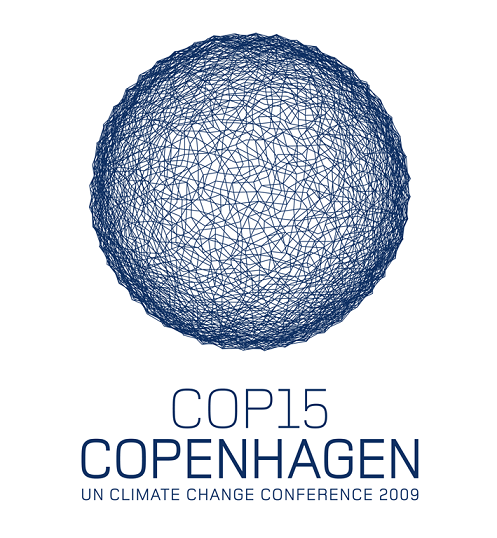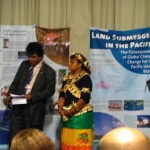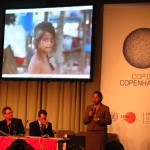
The effort to combat climate change is often tackled from a public policy perspective. Although this approach is crucial to the negotiations, it is only part of the solution. Today, I attended a lecture titled “Green Building U.S. Technology,” which focused largely on programs within the United States and their efforts to go green. One example mentioned was the Empire State Building and the construction that was done to make it sustainable. One example was the installation of new windows that reduced the sunlight intensity so that less air conditioning was needed to cool the building. This project, along with a host of efforts to reduce carbon emissions in the United States, requires the collaboration of both the public and private sector.
An instance of positive public-private collaboration can be seen in Saginaw, Michigan, where the Saginaw Future, Inc., the Michigan Economic Development Corporation, and the Saginaw County Chamber of Commerce worked together to invest $1-Billion in solar development. Ultimately, this project will assist in the development of green jobs and ultimately lead to less energy consumption. This collaboration was recognized by the United States Department of Congress and is an excellent example of how cross-sectoral collaboration is needed in the fight to end climate change.
With this, it should come as no surprise that numerous non-governmental agencies have been invited to participate in the United Nations Conference on Climate Change. Through their input, which is largely in the form of scientific research, a conclusion can hopefully be reached and executed around the world to address the issue of climate change from a variety of angles.
Tags: climate change, interconnectivity, Private Sector, Public Policy, Public Sector
Most side events (events other than the main party negotiation) at COP15 have been in the form of presenting research results, describing current mechanisms and suggesting what directions to take in climate change mitigation going forward. They all rely heavily on fact and reasoning to make the case. Kiribati event, in contrast, appeals to ethics and emotions.
Some background information on Kiribati:
The Republic is Kiribati is an island nation in the central tropical Pacific Ocean. It has a total area is only 720 km2 and supports a population of 98,000 people. The country is on average only 2 meters above sea level, making it one of countries the most vulnerable to climate change and sea level rise. With the current pace of sea level rise, the country will face serious water supply, food security and land loss problems, possibly making it inhabitable within one generation. So the Kiribati may not be there anymore in the coming decades. In the climate change negotiation arena, Kiribati is part of the Alliance of Small Island States (AOSIS).
At the event, the stage was decorated with traditional fabrics and souvenir. Each attendee was given a necklace made of sea shells. Several Kiribatin women in traditional dress greeted the attendees. The event started with a video introducing the country and the danger of climate change it is facing. There were beautiful images of tropical landscapes, native traditional ceremonies and other cultural activities. After that, the panelists greeted the guest in their language, saying Mauri for ‘wishing you health’. Half way through the event, there was a live performance of the traditional dance by a Kiribatian woman in beautiful and colorful traditional dress. During the Q&A session, the screen showed an image of a native child looking at the audience asking “What will be my future?”.
This was by far the most touching event I have attended at the conference. It is so different from other events in that it presented the human side of climate change. It appeals to ethics. With all the negotiation and practical bargaining happening at COP15, I wonder how far an appeal to ethics can go.
Tags: AOSIS, COP15 Resources, Kiribati, Luan Nguyen
 In the Victor Borg room this afternoon, a panel of officials spoke of the pressing need to emphasize the connection between Climate Change and Food Security. The panelists spoke of the challenges facing farmers and the agricultural community around the world, particularly in developing countries, whose are the most vulnerable to the economic challenges presented by agricultural failure. Farmers, who rely on predictable weather patterns to grow and harvest their crops, are facing tremendous challenges as climate zones shift due to atmospheric warming. An increase of 2 or more degrees would mean the collapse of most agriculture, says Gilberto Camara, the General Director of Brazil’s National Institute for Space Research. Such a collapse would derive countries around the world not only of their immediate food supply, but of the economic ability to confront the challenges at hand.
In the Victor Borg room this afternoon, a panel of officials spoke of the pressing need to emphasize the connection between Climate Change and Food Security. The panelists spoke of the challenges facing farmers and the agricultural community around the world, particularly in developing countries, whose are the most vulnerable to the economic challenges presented by agricultural failure. Farmers, who rely on predictable weather patterns to grow and harvest their crops, are facing tremendous challenges as climate zones shift due to atmospheric warming. An increase of 2 or more degrees would mean the collapse of most agriculture, says Gilberto Camara, the General Director of Brazil’s National Institute for Space Research. Such a collapse would derive countries around the world not only of their immediate food supply, but of the economic ability to confront the challenges at hand.
IFAP president Ajay Vashnee says that the link between climate change and food security needs to be clearly articulated and recognized at these negotiations. “We have to win the battle against hunger and climate change,” says Vashnee, “and we have to do it at the same time.”
US Youth Crash Climate Denier Live Webcast in Copenhagen
Young Clean Energy Advocates called “Hitler Youth”
COPENHAGEN, DENMARK – Fifty young Americans took over a climate denier conference hosted by a prominent conservative organization this evening in Copenhagen, rushing the stage and telling the live TV audience that a clean energy future is the real road to prosperity in America. The young people, merely a fraction of the more than 350 US youth in Denmark for the UN climate negotiations, entered a session of the Americans for Prosperity “Hot Air Tour” speakers series and were able to drop two banners and gain access to the conference’s stage. The live event was webcast to over forty climate denier rallies in cities across the United States. See a video at http://bit.ly/4FAljl and pictures at http://is.gd/5hbUR.
The students entered the event in small groups, joining a paltry audience of five conference attendees, who had come to hear climate denier Lord Christopher Monckton speak about the Copenhagen climate negotiations. After the first five minutes of the event, student representatives from SustainUS, the Sierra Student Coalition, the Cascade Climate Network, and other American youth NGOs displayed banners reading “Climate Disaster Ahead” and “Clean Energy Now.” After security agents at the event took the banners, the young attendees began a chant of “Real Americans for Prosperity are Americans for Clean Energy.” The chant lasted five minutes, as the youth took the stage and displayed their message for the live video feed being sponsored by Americans for Prosperity, despite evasive action by Americans for Prosperity President Tim Phillips and his camera crew. As they left the stage, Lord Monckton repeatedly called the activists “crazed Hitler Youth” and “nazis.”



Your Comments